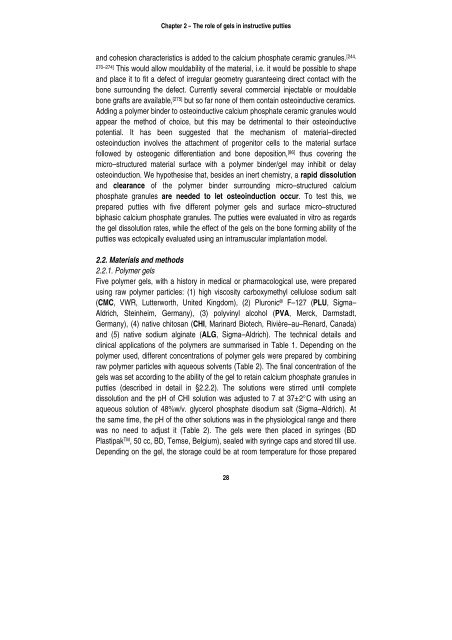Barbieri Thesis - BioMedical Materials program (BMM)
Barbieri Thesis - BioMedical Materials program (BMM)
Barbieri Thesis - BioMedical Materials program (BMM)
You also want an ePaper? Increase the reach of your titles
YUMPU automatically turns print PDFs into web optimized ePapers that Google loves.
Chapter 2 – The role of gels in instructive putties<br />
and cohesion characteristics is added to the calcium phosphate ceramic granules. [244,<br />
270–274] This would allow mouldability of the material, i.e. it would be possible to shape<br />
and place it to fit a defect of irregular geometry guaranteeing direct contact with the<br />
bone surrounding the defect. Currently several commercial injectable or mouldable<br />
bone grafts are available, [275] but so far none of them contain osteoinductive ceramics.<br />
Adding a polymer binder to osteoinductive calcium phosphate ceramic granules would<br />
appear the method of choice, but this may be detrimental to their osteoinductive<br />
potential. It has been suggested that the mechanism of material–directed<br />
osteoinduction involves the attachment of progenitor cells to the material surface<br />
followed by osteogenic differentiation and bone deposition, [86] thus covering the<br />
micro–structured material surface with a polymer binder/gel may inhibit or delay<br />
osteoinduction. We hypothesise that, besides an inert chemistry, a rapid dissolution<br />
and clearance of the polymer binder surrounding micro–structured calcium<br />
phosphate granules are needed to let osteoinduction occur. To test this, we<br />
prepared putties with five different polymer gels and surface micro–structured<br />
biphasic calcium phosphate granules. The putties were evaluated in vitro as regards<br />
the gel dissolution rates, while the effect of the gels on the bone forming ability of the<br />
putties was ectopically evaluated using an intramuscular implantation model.<br />
2.2. <strong>Materials</strong> and methods<br />
2.2.1. Polymer gels<br />
Five polymer gels, with a history in medical or pharmacological use, were prepared<br />
using raw polymer particles: (1) high viscosity carboxymethyl cellulose sodium salt<br />
(CMC, VWR, Lutterworth, United Kingdom), (2) Pluronic ® F–127 (PLU, Sigma–<br />
Aldrich, Steinheim, Germany), (3) polyvinyl alcohol (PVA, Merck, Darmstadt,<br />
Germany), (4) native chitosan (CHI, Marinard Biotech, Rivière–au–Renard, Canada)<br />
and (5) native sodium alginate (ALG, Sigma–Aldrich). The technical details and<br />
clinical applications of the polymers are summarised in Table 1. Depending on the<br />
polymer used, different concentrations of polymer gels were prepared by combining<br />
raw polymer particles with aqueous solvents (Table 2). The final concentration of the<br />
gels was set according to the ability of the gel to retain calcium phosphate granules in<br />
putties (described in detail in §2.2.2). The solutions were stirred until complete<br />
dissolution and the pH of CHI solution was adjusted to 7 at 37±2°C with using an<br />
aqueous solution of 48%w/v. glycerol phosphate disodium salt (Sigma–Aldrich). At<br />
the same time, the pH of the other solutions was in the physiological range and there<br />
was no need to adjust it (Table 2). The gels were then placed in syringes (BD<br />
Plastipak TM , 50 cc, BD, Temse, Belgium), sealed with syringe caps and stored till use.<br />
Depending on the gel, the storage could be at room temperature for those prepared<br />
28





